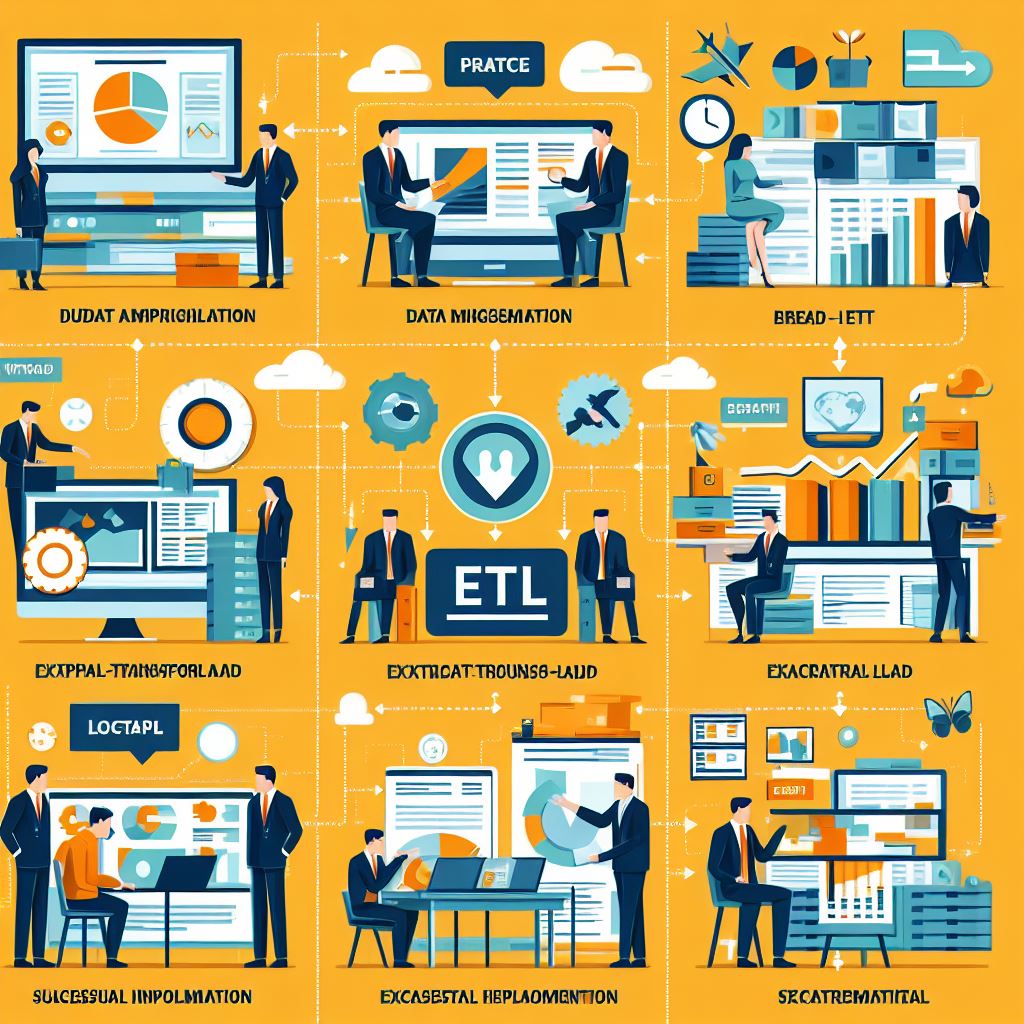Data migration is a critical process that involves moving data from one system to another, and it plays a crucial role in modern businesses’ data management strategies. In this article, we will explore how Extract, Transform, and Load (ETL) processes transform the data migration process, addressing the basics of ETL and data migration, choosing the right tools for data migration, best practices, overcoming challenges, and ensuring data security and compliance.
Contents
- 1 The Basics of ETL and Data Migration
- 2 Choosing the Right Tools for Data Migration
- 3 Best Practices for Data Migration and ETL
- 4 Overcoming Challenges in Data Integration and ETL
- 5 Ensuring Data Security and Compliance in ETL for Data Migration
- 6 Frequently Asked Questions [FAQs]
- 6.1 Q: What is ETL, and how does it relate to data migration?
- 6.2 Q: What are some common data migration challenges?
- 6.3 Q: How does ETL help in resolving data migration challenges?
- 6.4 Q: What are the key differences between ETL and data migration tools?
- 6.5 Q: How does ETL handle big data in the context of data migration?
- 6.6 Q: What are the best practices for data migration using ETL?
- 6.7 Q: How does cloud data impact the ETL process in data migration?
- 6.8 Q: What role does data integration play in the data migration process?
- 6.9 Q: How does ETL facilitate data analytics in the context of data migration?
- 6.10 Q: What are the key stages in the ETL process for data migration?
- 7 Conclusion
The Basics of ETL and Data Migration

What is ETL, and how does it relate to data migration?
ETL refers to the process of extracting data from a source system, transforming it into a meaningful format, and loading it into a target database. In the context of data migration, ETL ensures that data from the source system is suitably formatted and integrated into the new system.
Why is ETL crucial in the data migration process?
ETL is crucial in the data migration process as it enables data to be efficiently transformed and loaded into the target system while ensuring data integrity and consistency. It allows businesses to seamlessly migrate large volumes of data without compromising quality.
Common challenges in using ETL for data migration
Challenges in using ETL for data migration may include data quality issues, data extraction complexities, and managing the transition from one system to another. Overcoming these challenges is essential for a successful data migration process.
Choosing the Right Tools for Data Migration

Key features to consider when selecting ETL tools for data migration
When choosing ETL tools for data migration, it is essential to consider features such as scalability, ease of use, compatibility with various data formats, and support for data integration. These features ensure that the selected tools can effectively handle the complexities of the data migration process.
Comparison of popular data migration and ETL tools
There are various data migration and ETL tools available in the market, including Informatica, Talend, and Apache Nifi, each with its unique features and capabilities. Comparing these tools can help organizations make informed decisions based on their specific data migration requirements.
Addressing data formats and data integration in the migration process
Data formats and integration play a vital role in the migration process. Choosing tools that support a wide range of data formats and seamless integration capabilities can simplify the migration process and ensure a smooth transition to the new system.
Best Practices for Data Migration and ETL

How to effectively manage volumes of data during migration
Effective management of large volumes of data during migration involves implementing strategies such as data partitioning, parallel processing, and efficient data compression techniques. These practices help optimize the migration process and reduce the overall time required for data transfer.
Strategies for data extraction and transformation in ETL processes
Data extraction and transformation require careful planning and execution. Utilizing efficient ETL processes and tools, businesses can implement strategies to streamline data extraction and transformation while ensuring data consistency and accuracy throughout the migration process.
Managing the transition from one system to another through ETL
Effective management of the transition from one system to another involves meticulously planning the data migration process, ensuring minimal downtime, and validating the migration results to guarantee a seamless transition without disrupting business operations.
Overcoming Challenges in Data Integration and ETL

Addressing data quality and integrity issues during data migration
Data quality and integrity issues can significantly impact the success of the migration process. Addressing these challenges involves implementing data cleansing and validation procedures to ensure the accuracy and reliability of the migrated data.
Common pitfalls to avoid in the ETL process for data migration
Avoiding common pitfalls in the ETL process involves conducting thorough data validation, ensuring compatibility between source and target systems, and implementing robust error-handling mechanisms. By proactively addressing these pitfalls, organizations can minimize the risk of data migration failures.
Utilizing data warehouses in the context of data integration and ETL
Data warehouses play a vital role in data integration and ETL processes. By centralizing and organizing data from various sources, data warehouses provide a unified platform for data transformation, analysis, and reporting, facilitating efficient data integration and migration processes.
Ensuring Data Security and Compliance in ETL for Data Migration

Implementing data management practices to ensure secure data migration
Implementing robust data management practices, including encryption, access controls, and data masking, is essential to ensure secure data migration. By prioritizing data security measures, organizations can safeguard sensitive information during the migration process.
Compliance considerations in data migration and ETL processes
Compliance with industry regulations and data protection laws is crucial in data migration and ETL processes. Organizations must adhere to data privacy standards, document the data migration process, and ensure transparency to comply with regulatory requirements.
Best practices for maintaining data security during the migration process
Best practices for maintaining data security during the migration process involve conducting regular security assessments, implementing comprehensive data backup procedures, and monitoring data access and usage to mitigate potential security threats throughout the migration journey.
Frequently Asked Questions [FAQs]
Q: What is ETL, and how does it relate to data migration?
ETL stands for extract, transform, load. It is a process of extracting data from various sources, transforming it into a consistent format, and loading it into a data warehouse or target system. ETL plays a crucial role in the data migration process as it ensures that data is properly transformed and loaded into the desired destination.
Q: What are some common data migration challenges?
Common data migration challenges include data consistency, data quality, migration tool limitations, data mapping complexities, and potential downtime during the migration process. It is important to address these challenges to ensure a successful data migration.
Q: How does ETL help in resolving data migration challenges?
ETL tools offer capabilities to handle data transformations, data cleansing, and data validation, which can help address challenges related to data quality and consistency during the data migration process. ETL tools also provide features for error handling and data reconciliation.
Q: What are the key differences between ETL and data migration tools?
ETL tools are primarily designed for data integration and transformation, while data migration tools are focused on moving data from one system to another with minimal impact on ongoing operations. While there is some overlap in functionality, the primary difference lies in their core purposes.
Q: How does ETL handle big data in the context of data migration?
ETL tools are equipped to handle large volumes of data, making them suitable for migrating big data. They can efficiently extract, transform, and load massive datasets from different sources into a target system or a data warehouse, ensuring a smooth migration process for big data environments.
Q: What are the best practices for data migration using ETL?
Best practices for data migration with ETL include thorough data profiling and analysis, establishing clear data mapping rules, conducting comprehensive testing, maintaining data lineage, and ensuring proper documentation of the migration process.
Q: How does cloud data impact the ETL process in data migration?
Cloud data introduces considerations related to network bandwidth, data security, and integration with cloud platforms. ETL tools need to adapt to accommodate cloud-based data sources and targets, ensuring seamless data migration between on-premises and cloud environments.
Q: What role does data integration play in the data migration process?
Data integration refers to the process of combining data from different sources into a unified view. In the context of data migration, data integration is crucial for ensuring that data from multiple sources is consolidated, transformed, and migrated to the target system effectively.
Q: How does ETL facilitate data analytics in the context of data migration?
ETL processes play a critical role in preparing data for analytics by transforming and consolidating data from various sources into a format suitable for analysis. This enables organizations to leverage the migrated data for meaningful insights and decision-making through data analytics.
Q: What are the key stages in the ETL process for data migration?
The ETL process for data migration typically involves extracting data from the source system, transforming the data to meet the requirements of the target system, and loading the transformed data into the destination system. These three stages form the core of the ETL process for effective data migration.
Conclusion
The ETL process, when correctly implemented, can wholly transform the way you manage your data migration. It not only streamlines the process but also ensures data integrity, scalability, and improved decision-making within your organization. This deep dive into how ETL transforms the data migration process should give you a solid understanding of its significance and benefits. The power to make data-driven decisions lies in efficient data handling, and ETL is your key to unlocking it. It’s time to consider how can ETL transform your data migration process.





